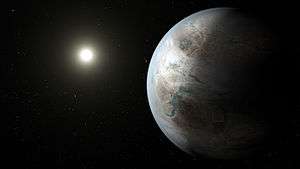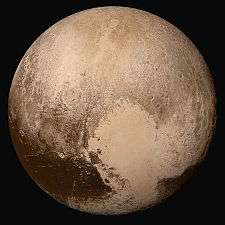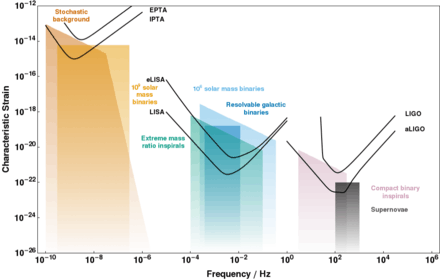LISA Pathfinder
.jpg) Model of the LISA Pathfinder spacecraft | |
| Mission type | Technology demonstrator |
|---|---|
| Operator | ESA[1] |
| Website |
sci |
| Mission duration | Nominal: 1 year[1] (with sufficient Cold Gas for mission extension) |
| Spacecraft properties | |
| Manufacturer | Airbus Defence and Space |
| Launch mass | 1,910 kg (4,210 lb)[1] |
| BOL mass | 480 kg (1,060 lb)[2] |
| Dry mass | 810 kg (1,790 lb) |
| Payload mass | 125 kg (276 lb) |
| Dimensions | 2.9 m × 2.1 m (9.5 ft × 6.9 ft) |
| Start of mission | |
| Launch date | 3 December 2015, 04:04:00 UTC[3][4][5] |
| Rocket | Vega |
| Launch site | Kourou ELV |
| Contractor | Arianespace |
| Orbital parameters | |
| Reference system | Sun–Earth L1 |
| Regime | Lissajous orbit |
| Periapsis | 500,000 km (310,000 mi) |
| Apoapsis | 800,000 km (500,000 mi) |
| Inclination | 60 degrees |
| Epoch | Planned |
| Transponders | |
| Band | X band |
| Bandwidth | 7 kbit/s |
| Instruments | |
| ~36.7 cm Laser interferometer | |
LISA Pathfinder, formerly Small Missions for Advanced Research in Technology-2 (SMART-2), is an ESA spacecraft that was launched on 3 December 2015.[3][4][5] The mission will test technologies needed for the Evolved Laser Interferometer Space Antenna (eLISA), an ESA gravitational wave observatory planned to be launched in 2034. The scientific phase started on 8 March 2016 and will last 6 months.[6] In April 2016 ESA announced that LISA Pathfinder demonstrated that eLISA mission is feasible.
The estimated mission cost is €400 million.[7]
Mission
LISA Pathfinder will place two test masses in a nearly perfect gravitational free-fall, and will control and measure their relative motion with unprecedented accuracy. The laser interferometer measures the relative position and orientation of the masses 40 centimetres apart to an accuracy of less than 0.01 nanometres,[8] a technology estimated to be sensitive enough to detect gravitational waves by the follow-on mission, eLISA.
LISA Pathfinder is an ESA-led mission. It involves European space companies and research institutes from France, Germany, Italy, The Netherlands, Spain, Switzerland, UK, and the US space agency NASA.[9]
LISA Pathfinder science
LISA Pathfinder is a proof-of-concept mission to prove that the two masses can fly through space, untouched but shielded by the spacecraft, and maintain their relative positions to the precision needed to realise a full gravitational wave observatory planned for launch in 2034. The primary objective is to measure deviations from geodesic motion. Much of the experimentation in gravitational physics requires measuring the relative acceleration between free-falling, geodesic reference test particles.[10]
In LISA Pathfinder, precise inter-test-mass tracking by optical interferometry will allow scientists to assess the relative acceleration of the two test masses, situated about 38 cm apart in a single spacecraft. The science of LISA Pathfinder consists of measuring and creating an experimentally-anchored physical model for all the spurious effects – including stray forces and optical measurement limits – that limit the ability to create, and measure, the perfect constellation of free-falling test particles that would be ideal for the eLISA follow up mission.[11]
In particular, it will verify:
- Drag-free attitude control of a spacecraft with two proof masses,
- The feasibility of laser interferometry in the desired frequency band (which is not possible on the surface of Earth), and
- The reliability and longevity of the various components—capacitive sensors, microthrusters, lasers and optics.
For the follow-up mission, eLISA,[12] the test masses will be 2 kg cubes housed in two separate spacecraft one million kilometers apart.
Spacecraft design
LISA Pathfinder was built by Airbus Defence and Space of Stevenage, UK under contract to the European Space Agency. It carries a European 'LISA Technology Package' comprising inertial sensors, interferometer and associated instrumentation as well as two drag-free control systems: a European one using cold gas micro-thrusters (similar to those used on Gaia), and a US-built 'Disturbance Reduction System' using the European sensors and an electric propulsion system that uses ionised droplets of a colloid accelerated in an electric field.[13] The colloid thruster (or "electrospray thruster") system was built by Busek and delivered to JPL for integration with the spacecraft.[14]
Instrumentation
The LISA Technology Package (LTP) was integrated by Airbus Defence and Space Germany, but the instruments and components were supplied by contributing institutions across Europe. The noise rejection technical requirements on the interferometer were very stringent, which means that the physical response of the interferometer to changing environmental conditions, such as temperature, must be minimised.
Environmental influences
On the follow-up mission, eLISA, environmental factors will influence the measurements the interferometer takes. These environmental influences include stray electromagnetic fields and temperature gradients, which could be caused by the Sun heating the spacecraft unevenly, or even by warm instrumentation inside the spacecraft itself. Therefore, LISA Pathfinder is designed to find out how such environmental influences change the behaviour of the inertial sensors and the other instruments. LISA Pathfinder flies with an extensive instrument package which can measure temperature and magnetic fields at the test masses and at the optical bench. The spacecraft is even equipped to stimulate the system artificially: it carries heating elements which can warm the spacecraft's structure unevenly, causing the optical bench to distort and enabling scientists to see how the measurements change with varying temperatures.[15]
Lissajous orbit
The spacecraft was first launched into an elliptical LEO parking orbit. From there it will execute a short burn each time perigee is passed, slowly raising the apogee closer to the intended halo orbit around the Earth–Sun L1 point.[1][16][17]
Spacecraft operations
Mission control for LISA Pathfinder is at ESOC in Darmstadt, Germany with science and technology operations controlled from ESAC in Madrid, Spain.[18]
Status
The spacecraft reached its operational location in orbit around the Lagrange point L1 on 22 January 2016, where it underwent payload commissioning.[19] The testing started on 1 March 2016.[20] In April 2016 ESA announced that LISA Pathfinder demonstrated that eLISA mission is feasible.[21]
On 7 June 2016, ESA presented the first results of two months of science operation show that the technology developed for a space-base gravitational wave observatory was exceeding expectations. The two cubes at the heart of the spacecraft are falling freely through space under the influence of gravity alone, unperturbed by other external forces, to a factor of 5 better than requirements for LISA Pathfinder.[22][23][24]
Possible mission extension
A possible mission extension would perform some measurements to confirm the general relativity theory. By flying through the saddle point where the Earth and Sun's gravity cancel out, the spacecraft might prove whether Einstein's theory still holds when gravitational accelerations are extremely small. If it does, it would test theoretical alternatives of general relativity, such as Modified Newtonian Dynamics (MOND) and TeVeS.[25]
See also
- Einstein Telescope, a European gravitational wave detector
- GEO600, a gravitational wave detector located in Hannover, Germany
- LIGO, a gravitational wave observatory in USA
- Virgo interferometer, an interferometer located close to Pisa, Italy
References
- 1 2 3 4 "LISA Pathfinder: Operations". ESA. 8 January 2010. Retrieved 5 February 2011.
- ↑ "LPF (LISA Pathfinder) Mission". ESA eoPortal. Retrieved 2014-03-28.
- 1 2 "Launch Schedule". SpaceFlight Now. Retrieved 2015-10-16.
- 1 2 "Call for Media: LISA Pathfinder launch". ESA. 23 November 2015.
- 1 2 "LISA Pathfinder enroute to gravitational wave demonstration". European Space Agency. Retrieved 3 December 2015.
- ↑ https://www.elisascience.org/news/top-news/lpfscienceoperationsbegin
- ↑ "LISA Pathfinder To Proceed Despite 100% Cost Growth". Space News. 22 June 2011.
- ↑ LISA Pathfinder Ready for Launch from Kourou, SpaceRef, Airbus Defence and Space. November 30, 2015.
- ↑ "LISA Pathfinder international partners". eLISAscience.org. Retrieved 7 September 2015.
- ↑ science objective of LISA Pathfinder.
- ↑ "LISA Pathfinder Science". eLISAscience.org. Retrieved 9 July 2014.
- ↑ LISA
- ↑ Ziemer, J.K.; and Merkowitz, S.M.: “Microthrust Propulsion of the LISA Mission,” AIAA–2004–3439, 40th AIAA/ASME/SAE/ASEE Joint Propulsion Conference, Fort Lauderdale FL, July 11–14, 2004.
- ↑ Rovey, J. "Propulsion and Energy: Electric Propulsion (Year in Review, 2009)" (PDF). Aerospace America, December 2009, p. 44.
- ↑ "LISA Pathfinder Technology". eLISAscience.org. Retrieved 9 July 2014.
- ↑ "LISA Pathfinder: Mission home". ESA. Retrieved 5 February 2011.
- ↑ "ESA's new vision to study the invisible universe". www.esa.int. Retrieved 26 June 2014.
- ↑ "LISA Pathfinder: Fact sheet". ESA. Retrieved 20 April 2009.
- ↑ "First locks released from LISA Pathfinder's cubes". ESA. ESA Press Release. February 3, 2016. Retrieved 2016-02-12.
- ↑ Amos, Jonathan (1 March 2016). "Gravitational waves: Tests begin for future space observatory". BBC News. Retrieved 2016-03-01.
- ↑ Gravitational Observatory Advisory Team, ed. (28 March 2016). The ESA–L3 Gravitational Wave Mission - Final Report (PDF). ESA–L3 Final Report. p. 4.
- ↑ M. Armano; et al. (2016). "Sub-Femto-g Free Fall for Space-Based Gravitational Wave Observatories: LISA Pathfinder Results". Physical Review Letters. 116 (23). doi:10.1103/PhysRevLett.116.231101.
- ↑ "LISA Pathfinder exceeds expectations". ESA. 7 June 2016. Retrieved 7 June 2016.
- ↑ "LISA Pathfinder exceeds expectations". Benjamin Knispel. elisascience.org. 7 June 2016. Retrieved 7 June 2016.
- ↑ New Scientist. 2 March 2013; page 44
External links
| Wikimedia Commons has media related to LISA Pathfinder. |
- eLISA and LISA Pathfinder's Homepage
- Videos for LISA Pathfinder on eLISAscience.org
- LISA Pathfinder mission home at ESA
- LISA Pathfinder at eoPortal
- Max Planck Institute for Gravitational Physics (Albert Einstein Institute Hannover)




